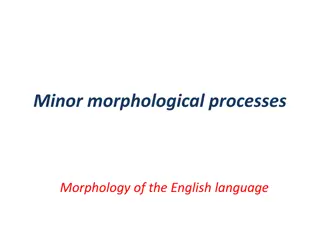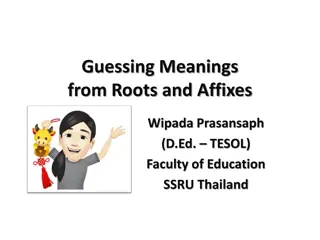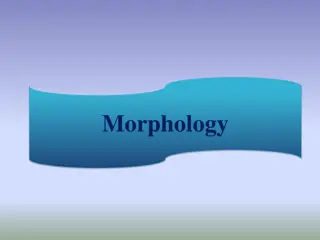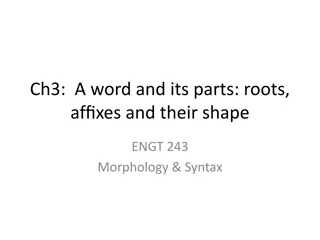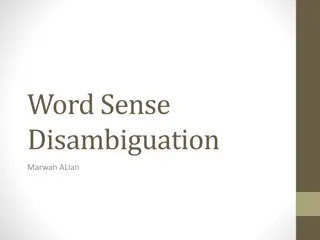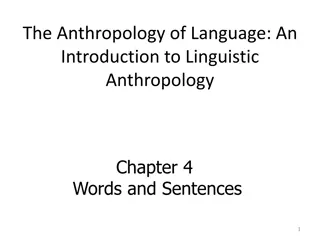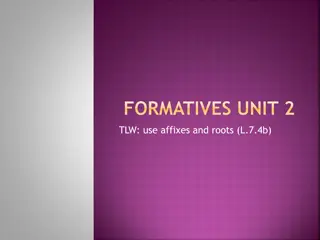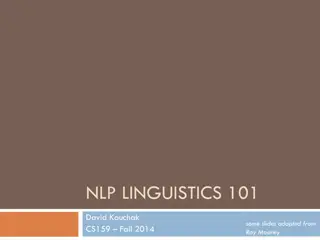Ways of Enlarging the Vocabulary of a Language Word-Formation and Borrowing in Modern English.
Explore various types of word-building processes in Modern English, including morphological, syntactic, and mixed methods like affixation, composition, conversion, and borrowing. Understand the classifications of affixes, techniques in morphological word-building, and the diversity of the English vo
4 views • 31 slides
Minor Morphological Processes in English Language
Explore minor morphological processes in the English language, including word-building processes like conversion and clipping. Conversion involves changing a word's part of speech without affixes, while clipping shortens words without altering meaning. Acronyms and abbreviations are also discussed i
10 views • 12 slides
DERIVATIONAL MORPHOLOGY. PREFIXATION.
Derivational morphology in the English language involves forming new words by adding affixes to a base, resulting in derivatives or derived words. Prefixation is a productive process, especially for verb and adjective formation. Prefixes can be classified based on their meanings, such as negative, p
6 views • 6 slides
Word Meanings Through Roots and Affixes in Education
Exploring how to decipher unfamiliar words by analyzing their roots, prefixes, and suffixes from a linguistic perspective. Latin roots and examples are provided to demonstrate how word parts contribute to the overall meaning of a word.
3 views • 69 slides
Morphology: Word Structure and Morphemes
Morphology, a branch of linguistics, focuses on word structure by examining morphemes, which are the smallest meaningful units of language. Morphemes can be free or bound, with bound morphemes modifying the meaning of free morphemes through affixes like prefixes and suffixes. Types of affixes includ
1 views • 14 slides
Enhancing English Language Skills with Suffixes and Prefixes Challenge
Explore the world of suffixes and prefixes with engaging exercises focused on enhancing English language skills. By adding the correct affixes to the root words, students can reinforce their understanding of word formation and meaning. Challenge yourself with practical examples related to everyday s
2 views • 26 slides
Morphology: Roots, Affixes, and Shape of Words
This chapter delves into the study of morphology, focusing on morphemes as the building blocks of words. It discusses the characteristics of morphemes, their importance in determining word meaning, and how they contribute to the structure of complex words. By examining examples like "helpfulness" an
5 views • 38 slides
Word Sense Disambiguation: Challenges and Approaches
Word Sense Disambiguation (WSD) is a complex task in artificial intelligence that aims to determine the correct sense of a word in context. It involves classifying a word into predefined classes based on its meaning in a specific context. WSD requires not only linguistic knowledge but also knowledge
6 views • 12 slides
Formative Unit 1 - Affixes and Roots Usage
Explore the use of affixes and roots in Formative Unit 1 with examples such as "antebellum," "antisocial," "overdue," "uniform," "monotone," and "foreshadow." Understand the meanings of prefixes like "ante," "anti," "over," "uni," "mono," and "fore," and how they alter the words they are attached to
0 views • 9 slides
Language Structure Explained: Prefixes, Suffixes, and Word Class Changes
Explore the concept of affixation with examples of adding prefixes and suffixes to base words, resulting in changes to word classes. Conversion examples illustrate how words can change classes without affixes. The content covers shifts in stress, compound words, and conversions from phrases to nouns
0 views • 25 slides
The Anthropology of Language: Words and Sentences Overview
Explore the anatomy of language from morphology to syntax, delving into the structure of words, morphemes, and sentences. Understand the analysis of morphemes and their arrangements, the descriptions of bases forming words, kinds of bases like roots and stems, and creating a language from base forms
0 views • 31 slides
Word Formation and Coinage in English
Word formation in English involves different processes such as compounding, conversion, and derivational affixation. Compounding combines two or more words to create a new word, while conversion changes the word class without affixes. Word coinage includes compounds, acronyms, back-formations, abbre
1 views • 10 slides
Derivative Words and Prefixes in English Language
Delve into the world of derivative words, prefixes, and pronouns with insights on basic terms, the definition of prefixes, common prefixes in texts, prefixes' meanings and connotations, derivational suffixes, and a list of English words of Indonesian origin. Explore the modification and creation of
0 views • 21 slides
Effective Vocabulary Instruction in Content Areas
Research indicates that vocabulary learning in content areas is a gradual process involving multiple meanings, affixes, and root words. Instruction should focus on explicit teaching methods like the PEAR framework, incorporating broad learning opportunities and student-friendly definitions. The prep
0 views • 11 slides
Unlocking the Power of Affixes and Roots in Language Learning
Explore the world of affixes and roots through engaging formatives focusing on prefixes such as "trans," "inter," "ex," "non," "mis," "de," and "re." Learn how these affixes transform words and deepen your understanding of language. Dive into examples and sentence usage to enhance your vocabulary an
0 views • 9 slides
Prefixes and Suffixes for Word Formation
Explore the concept of prefixes and suffixes, essential elements in word formation. Learn how adding these affixes to words can change their meanings and create new vocabulary. Through examples and explanations, grasp the significance of prefixes and suffixes in expanding your language skills.
0 views • 15 slides
Lexical Categories in Morphology
Explore the world of lexical categories, morphology, and affixes to enhance your grasp of grammar concepts. Dive into the definitions of nouns, verbs, adjectives, prepositions, pronouns, articles, conjunctions, and adverbs. Learn about affixes such as prefixes, suffixes, infixes, and circumfixes, an
1 views • 12 slides
Fun with Prefixes and Suffixes in English Language Class
Explore the world of prefixes and suffixes in an English Language Class taught by Md. Shofiqur Rahman, Assistant Headteacher at Munir Gati High School. Understand the concepts of affixes, create new words with prefixes and suffixes, and enhance your vocabulary skills. Dive into learning outcomes, co
0 views • 27 slides
Morphology: Building Blocks of Language
Morphology is the study of the internal structure of words and how they are formed from morphemes, such as stems and affixes. By analyzing morphology, we can understand how words are created and related to each other, enabling us to generalize, obtain additional information, and handle new words eff
1 views • 49 slides
Medical Terminology: Prefixes and Suffixes
Medical terms often consist of prefixes and suffixes in addition to roots, requiring knowledge of common medical affixes to fully grasp their meanings. Prefixes are added to the front of a root word, while suffixes are attached to the end, indicating various conditions, procedures, or body parts. By
0 views • 5 slides
Affixes: Prefixes and Suffixes in English Vocabulary
Affixes are essential elements in vocabulary building, with prefixes added to the front of words and suffixes to the back, altering meanings or grammatical functions. Learn about the role and examples of prefixes and suffixes, and practice creating new words by combining roots with affixes to enhanc
0 views • 8 slides
Morphology in Linguistics
Morphology is a branch of linguistics that focuses on word structure and the smallest meaningful units of language known as morphemes. It delves into the decomposition of words and the classification of morphemes into bound and free categories. Bound morphemes, such as prefixes and suffixes, modify
0 views • 16 slides

